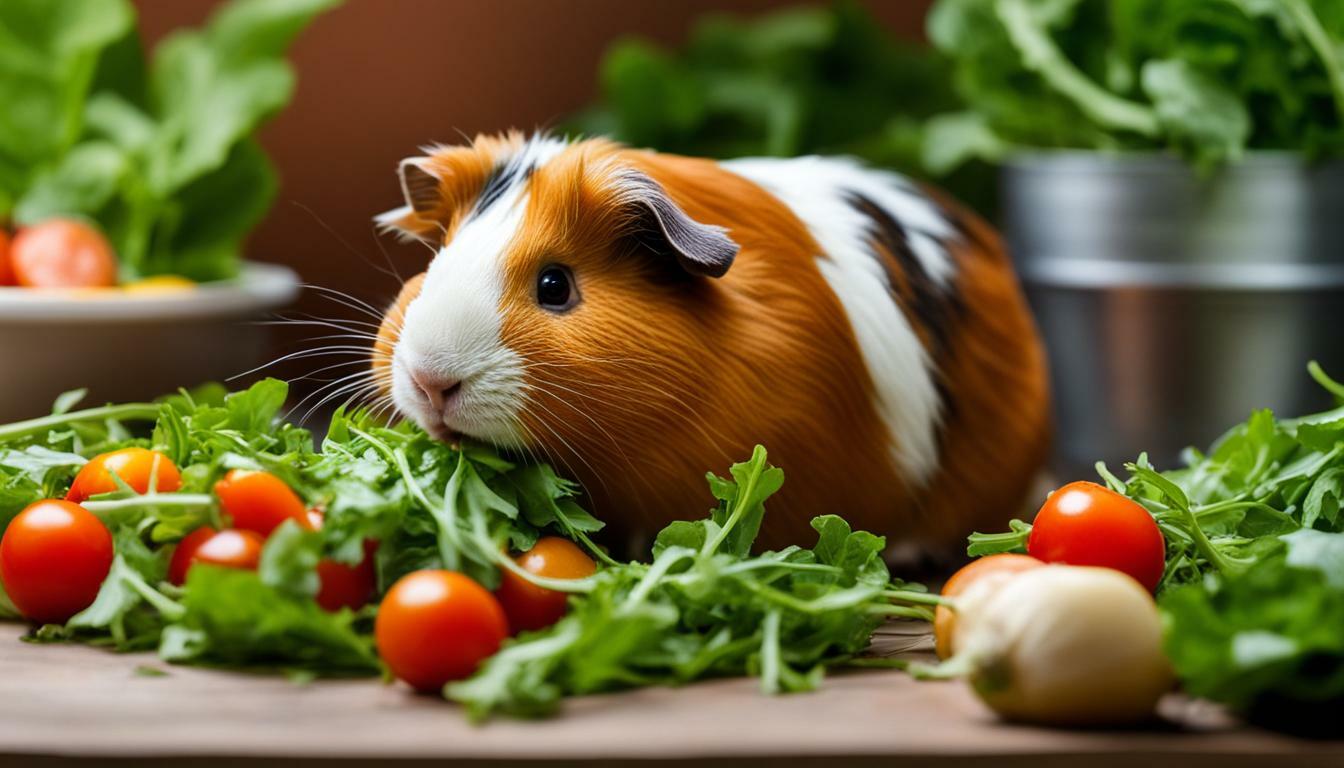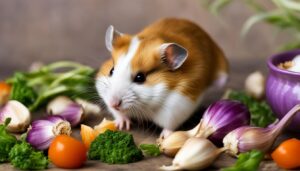Many guinea pig owners wonder if it is safe to include arugula in their pets’ diet. Guinea pigs can indeed eat arugula, but there are some important considerations to keep in mind.
Key Takeaways:
- Arugula is safe for guinea pigs to consume in moderation.
- It contains important nutrients such as Vitamin A, Vitamin K, and Vitamin C.
- Arugula is relatively high in calcium, so it should only be fed occasionally to prevent bladder stone issues.
- Other vegetables with higher vitamin C content, such as red bell peppers and parsley, are better options for guinea pigs.
- Arugula can be offered once a week or once every two weeks as part of a balanced diet for guinea pigs.
- It is essential to wash the arugula thoroughly before feeding it to guinea pigs.
- Include other vegetables in the diet to provide a variety of nutrients.
Understanding Guinea Pig Diets
A well-balanced diet is crucial for the overall health and well-being of guinea pigs. When it comes to their diet, it is important to provide them with a variety of foods that meet their nutritional needs. Guinea pigs are herbivores, which means their diet should consist mainly of fresh vegetables, hay, and a small amount of pellets.
Vegetables play a vital role in a guinea pig’s diet as they provide essential vitamins and minerals. However, not all vegetables are safe for guinea pigs to consume. It is important to choose vegetables that are safe and beneficial for their health. Safe vegetables for guinea pigs include leafy greens, such as lettuce, spinach, and arugula, as well as bell peppers, carrots, and cucumbers.
When it comes to guinea pig nutrition, one crucial aspect to consider is the vitamin C content. Guinea pigs, unlike humans, cannot produce their own vitamin C and therefore need to obtain it from their diet. Vegetables rich in vitamin C, such as red bell peppers and parsley, are excellent choices to ensure their daily vitamin C requirements are met. These vegetables also contain other essential nutrients that contribute to their overall health.
| Safe Vegetables for Guinea Pigs | Vitamin C Content (mg/100g) |
|---|---|
| Red Bell Peppers | 127.7 |
| Parsley | 133 |
| Arugula | 15 |
While arugula is safe for guinea pigs to consume, it should be offered in moderation due to its relatively high calcium content. Excessive calcium intake can lead to bladder stone issues in guinea pigs. It is recommended to feed arugula once a week or once every two weeks as part of a balanced diet. Before serving arugula or any other vegetables to your guinea pig, ensure that it is thoroughly washed to remove any potential contaminants.
In conclusion, understanding guinea pig diets is crucial for providing them with the necessary nutrition. It is important to offer a well-balanced diet that includes safe vegetables, such as arugula, while prioritizing vegetables with higher vitamin C content like red bell peppers and parsley. By incorporating a variety of vegetables into their diet and following proper precautions, you can ensure the overall health and well-being of your guinea pig.
Exploring Arugula Nutrition for Guinea Pigs
Arugula is a leafy green vegetable that offers a variety of nutrients that can be beneficial for guinea pigs. This vegetable is rich in vitamins, including Vitamin A, Vitamin K, and Vitamin C, which are essential for the overall health and well-being of guinea pigs. These vitamins support immune function, contribute to healthy bones and teeth, and aid in the absorption of other nutrients.
Additionally, arugula contains fiber, which promotes healthy digestion in guinea pigs. Fiber plays a crucial role in maintaining a healthy digestive system and preventing gastrointestinal issues. The high fiber content in arugula can help regulate the digestive process and prevent constipation.
| Nutrition Facts of Arugula for Guinea Pigs | |
|---|---|
| Vitamin A | Good |
| Vitamin K | Good |
| Vitamin C | Decent |
| Calcium | High |
| Fiber | Good |
However, it is important to note that arugula is relatively high in calcium. While guinea pigs require calcium for healthy bones and teeth, excessive calcium intake can lead to the formation of bladder stones. Therefore, it is recommended to offer arugula to guinea pigs in moderation, preferably once a week or once every two weeks.
When serving arugula to guinea pigs, make sure to wash it thoroughly to remove any potential contaminants. It is also advisable to introduce other vegetables into their diet to provide a variety of nutrients. Red bell peppers and parsley, for example, are excellent alternatives to arugula as they are higher in vitamin C and lower in calcium content.
Precautions When Feeding Arugula to Guinea Pigs
Although arugula can be a healthy addition to a guinea pig’s diet, it’s important to exercise caution due to its relatively high calcium levels. Guinea pigs are prone to developing bladder stones, and excessive calcium intake can contribute to their formation. While arugula contains valuable nutrients like Vitamin A, Vitamin K, and Vitamin C, overfeeding this leafy green can lead to health issues.
To ensure the well-being of your guinea pig, it’s recommended to offer arugula in moderation. A general guideline is to include it in their diet once a week or once every two weeks. This frequency allows them to benefit from the nutrients while minimizing the risk of bladder stone development. Remember that arugula should never be the sole vegetable in their diet, as variety is crucial for meeting their nutritional needs.
When feeding arugula to your guinea pig, it is crucial to wash it thoroughly to remove any contaminants that may be present. Organic arugula is the most desirable option, as it reduces the exposure to pesticides and other harmful chemicals. Additionally, always remove wilted or spoiled leaves before offering the arugula to your furry friend.
Summary:
Arugula can be a healthy part of a guinea pig’s diet, but it should be fed in moderation due to its high calcium content. Offer arugula once a week or once every two weeks to minimize the risk of bladder stone issues. Make sure to wash the arugula thoroughly before feeding it to your guinea pig, and include a variety of other vegetables to ensure a balanced diet. By following these precautions, you can safely incorporate arugula into your guinea pig’s nutritional routine.
| Precautions When Feeding Arugula to Guinea Pigs |
|---|
| Feed arugula in moderation |
| Include arugula in the diet once a week or once every two weeks |
| Wash arugula thoroughly before offering it to guinea pigs |
| Remove wilted or spoiled leaves before feeding arugula to guinea pigs |
| Include a variety of other vegetables in the diet |
Alternatives to Arugula for Guinea Pigs
If you’re looking for vegetables with higher Vitamin C content for your guinea pig, consider options like red bell peppers and parsley. These alternatives provide a greater nutritional value and can be a safer choice for your furry friend.
Red bell peppers are not only a rich source of Vitamin C but also contain antioxidants that can benefit your guinea pig’s overall health. They are low in calcium, which makes them a suitable option for regular consumption. Additionally, red bell peppers add a pop of color to your guinea pig’s diet and can be offered as a crunchy treat.
Parsley is another excellent alternative to arugula. It is packed with Vitamin C and other essential nutrients like Vitamin A and potassium. This herb can provide a flavorful addition to your guinea pig’s meals and contribute to their overall well-being. However, remember to offer parsley in moderation as it has a high water content.
| Vitamin Content | Arugula | Red Bell Peppers | Parsley |
|---|---|---|---|
| Vitamin C | Good | Excellent | Excellent |
| Vitamin A | Good | Moderate | Good |
| Calcium | High | Low | Moderate |
Remember to introduce any new vegetables gradually into your guinea pig’s diet and observe their response. Each guinea pig is unique, and some may have preferences or sensitivities to certain foods. Always consult with a veterinarian for personalized guidance on your guinea pig’s diet.
Frequency of Offering Arugula to Guinea Pigs
Due to its calcium content, arugula should only be offered occasionally to guinea pigs. While arugula is safe for them to consume, excessive calcium intake can lead to bladder stone issues in these small pets. Therefore, it is essential to feed arugula in moderation to maintain their overall health and well-being.
As part of a balanced diet for guinea pigs, arugula can be offered once a week or once every two weeks. This frequency ensures that they receive the nutritional benefits of arugula, including vitamins A, K, and C, without overloading on calcium. It is important to note that arugula should not make up the majority of a guinea pig’s diet and should be supplemented with other vegetables to provide a variety of nutrients.
When feeding arugula to guinea pigs, it is crucial to wash it thoroughly beforehand to remove any potential contaminants. By rinsing the arugula under cool running water, you can ensure that it is safe for your guinea pigs to consume. Additionally, it is advisable to offer other vitamin C-rich vegetables, such as red bell peppers or parsley, as alternatives to arugula, as these options provide more suitable levels of this essential nutrient for guinea pigs.
| Benefits of Offering Arugula to Guinea Pigs |
|---|
| Contains vitamins A, K, and C |
| Provides occasional variety in their diet |
| Can be a source of hydration |
| Contains fiber for digestive health |
Remember, the key to keeping your guinea pigs healthy is to provide a balanced and varied diet. While arugula can be a part of their diet, it should not be the sole vegetable they consume. By offering a diverse range of vegetables, you can ensure that your guinea pigs receive all the essential nutrients they need for optimal health. If you have any concerns about your guinea pig’s diet or health, consult a veterinarian for personalized advice.
Proper Preparation of Arugula for Guinea Pigs
Before offering arugula to your guinea pig, it is essential to wash it thoroughly to ensure their safety. Guinea pigs have sensitive digestive systems, and any contaminants or pesticides present on the arugula can be harmful to their health. To properly prepare arugula for your furry friend, follow these steps:
- Start by rinsing the arugula leaves under cool, running water. This will help remove any dirt or debris.
- Gently pat the leaves dry with a clean kitchen towel or paper towel. Excess moisture can lead to spoiled produce or digestive issues for guinea pigs.
- Trim off the tough stems and any wilted or discolored parts of the arugula leaves. You want to offer fresh and crisp leaves to your guinea pig.
- Once the arugula is properly washed and trimmed, you can serve it to your guinea pig. Remember to introduce new vegetables gradually to their diet and observe their response to ensure they tolerate arugula well.
By taking the time to wash and prepare arugula properly, you can provide your guinea pig with a safe and nutritious addition to their diet. Remember, offering a variety of vegetables alongside arugula is important for a balanced guinea pig diet. It is always recommended to consult with a veterinarian for specific dietary guidelines for your guinea pig.
| Safe Vegetables for Guinea Pigs | Vitamin C Content (mg per 100g) |
|---|---|
| Red Bell Peppers | 127.7 |
| Parsley | 130 |
| Arugula | 15 |
Importance of a Balanced Diet for Guinea Pigs
Providing a balanced and varied diet is essential to meet the nutritional needs of guinea pigs. These adorable critters require a combination of hay, pellets, fresh vegetables, and occasional fruits to maintain optimal health. One important aspect of their diet is the inclusion of leafy greens, which provide essential vitamins and minerals.
Arugula, a popular leafy green, can be a part of a guinea pig’s diet but should be given in moderation. While arugula offers valuable nutrients like Vitamin A, Vitamin K, and Vitamin C, it is relatively high in calcium. Too much calcium can lead to bladder stone issues in guinea pigs. Therefore, it is recommended to offer arugula once a week or once every two weeks.
For higher Vitamin C content, guinea pigs can benefit from other vegetables like red bell peppers and parsley. These alternatives can be fed more frequently to ensure guinea pigs receive adequate amounts of this crucial vitamin. Additionally, incorporating a variety of vegetables into their diet allows for a wider range of nutrients, promoting overall health and well-being.
| Vitamin C-rich Vegetables for Guinea Pigs |
|---|
| Red bell peppers |
| Parsley |
When offering arugula or any other leafy greens, it is important to wash them thoroughly before feeding them to your guinea pigs. This helps remove any potential contaminants that might be present on the leaves. By practicing good hygiene and ensuring the vegetables are clean, you can help protect your guinea pigs’ health.
In conclusion, a balanced diet is vital for guinea pigs, and leafy greens play a crucial role in meeting their nutritional requirements. While arugula can be included in their diet occasionally, it is important to consider the high calcium content and offer alternatives with higher Vitamin C content, such as red bell peppers and parsley. By providing a varied and nutritious diet, you can ensure the well-being and happiness of your guinea pigs.
The Role of Leafy Greens in a Guinea Pig’s Diet
Leafy greens are a crucial component of a guinea pig’s diet, providing important nutrients and promoting their well-being. When it comes to selecting the right leafy greens for your furry friend, it is essential to consider the nutritional content and the specific needs of guinea pigs. While arugula is safe for guinea pigs to consume, it should be offered in moderation due to its high calcium content.
Guinea pigs require a diet rich in Vitamin C, as they are unable to produce it on their own. Leafy greens such as red bell peppers and parsley are excellent sources of this essential vitamin, making them more suitable options for regular consumption. These vegetables not only provide the necessary nutrients but also help maintain healthy teeth and bones.
When offering arugula to your guinea pig, it is important to wash the leaves thoroughly to remove any potential contaminants. Additionally, it is recommended to include other vegetables in their diet to ensure a variety of nutrients. Remember, a balanced diet is key to your guinea pig’s overall health and well-being.
| Leafy Greens | Nutritional Benefits |
|---|---|
| Arugula | Contains Vitamin A, Vitamin K, and Vitamin C. Should be fed in moderation due to high calcium content. |
| Red Bell Peppers | Rich source of Vitamin C, aids in maintaining healthy teeth and bones. |
| Parsley | High in Vitamin C, helps support the immune system. |
Offering arugula once a week or once every two weeks can be a suitable frequency within a balanced diet. Remember to observe your guinea pig’s reaction and adjust accordingly. By providing a variety of leafy greens, you can ensure your furry companion receives the necessary nutrients for optimal health and happiness.
Conclusion
In conclusion, arugula can be safely consumed by guinea pigs in moderation as part of a balanced diet, with precautions to be taken due to its higher calcium content. Arugula is safe for guinea pigs to consume and contains a decent amount of nutrients such as Vitamin A, Vitamin K, and Vitamin C. However, it is important to note that arugula is relatively high in calcium, which can lead to bladder stone issues if fed excessively.
While arugula can be included in a guinea pig’s diet, it should be offered occasionally rather than as a staple food. Other vegetables with higher vitamin C content, such as red bell peppers and parsley, are better options for guinea pigs to meet their nutritional needs. These vegetables can provide the necessary nutrients without the risk of calcium-related health problems.
To ensure the safety of arugula for guinea pigs, it is crucial to wash it thoroughly before feeding it to them. This helps remove any potential contaminants that may be present on the leaves. Additionally, offering a variety of vegetables alongside arugula is essential to provide a balanced and nutritious diet for guinea pigs.
Overall, while arugula can be a healthy addition to a guinea pig’s diet, it is important to offer it in moderation and prioritize other vegetables with higher vitamin C content. By following these guidelines and considering the specific dietary needs of guinea pigs, owners can ensure their furry companions receive a well-rounded and nutritious diet.
FAQ
Can guinea pigs eat arugula?
Yes, guinea pigs can eat arugula in moderation.
Is arugula safe for guinea pigs?
Yes, arugula is safe for guinea pigs to consume.
What nutrients does arugula provide for guinea pigs?
Arugula contains nutrients such as Vitamin A, Vitamin K, and Vitamin C.
Should arugula be fed to guinea pigs regularly?
Arugula should only be fed occasionally to prevent bladder stone issues.
What are some alternatives to arugula for guinea pigs?
Red bell peppers and parsley are better options for guinea pigs due to their higher vitamin C content.
How often can arugula be offered to guinea pigs?
Arugula can be offered once a week or once every two weeks as part of a balanced diet.
How should arugula be prepared before feeding it to guinea pigs?
It is important to wash arugula thoroughly before feeding it to guinea pigs to remove any potential contaminants.
Why is a balanced diet important for guinea pigs?
A balanced diet, including a variety of vegetables, is important for the overall well-being of guinea pigs.
What is the role of leafy greens in a guinea pig’s diet?
Leafy greens, such as arugula, contribute to a guinea pig’s overall health and provide necessary nutrients.




